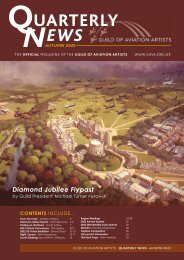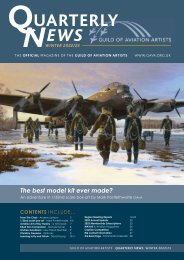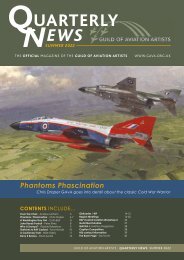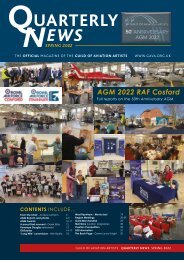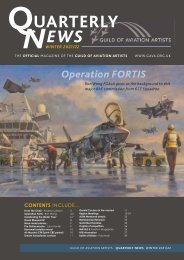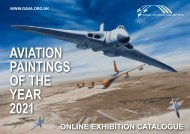Create successful ePaper yourself
Turn your PDF publications into a flip-book with our unique Google optimized e-Paper software.
Personal Reflections on Responsibility - from a new Full Member<br />
A Daunting Commission<br />
Graham Cooke VPGAvA<br />
As reported in the AGM article in a<br />
previous <strong>QN</strong>, I have, this year, been<br />
granted the privilege and honour of<br />
being promoted as a Full Member of the<br />
Guild. This unexpected surprise came in<br />
the form of a letter to me from Chairman<br />
Andrew which I received a few weeks<br />
ahead of the AGM.<br />
Contained in his most pleasant and<br />
welcome letter was the sentence:<br />
“it (promotion to Full member) also carries<br />
the responsibility to continue your support<br />
of Guild activities.”<br />
And it was this sentence that started me<br />
thinking about not only my own personal<br />
responsibilities to the Guild, but also the fact<br />
that the responsibility to the Guild is surely<br />
something that applies to us all – no matter<br />
what our individual rank or status is within the<br />
organisation.<br />
Like many of us, I’m old enough to remember<br />
JFK and exactly where I was on the day he<br />
was assassinated, November 22nd 1963 -<br />
(For what it’s worth…..playing on the carpet<br />
in Mum and Dad’s dining room with my<br />
favourite Dinky cars!!)<br />
In his inaugural address back in 1961, JFK<br />
famously included the words:<br />
“Ask not what your country can do for you –<br />
ask what you can do for your country”<br />
Surprisingly, in recent years, a Full Member<br />
of the Guild resigned as he had come<br />
to the conclusion that ‘having looked at<br />
his commitments – he had come to the<br />
conclusion that the Guild did not do enough<br />
for him to justify his annual subscription’……<br />
Surely this has to be the complete antithesis<br />
of JFK’s aspirations.<br />
Of course, JFK’s sentiment can be applied<br />
to anyone in any organisation or company.<br />
For myself, throughout my life, I have derived<br />
maximum enjoyment out of belonging to<br />
an organisation whenever I have put in the<br />
greatest contribution that I can.<br />
Like most hobby clubs, the Guild’s activities<br />
and organisation are carried out for the<br />
benefit of the whole membership and are<br />
arranged and managed by surprisingly few<br />
people. These very dedicated souls give<br />
selflessly of their time and effort –presumably,<br />
like me, because they get most satisfaction<br />
out of ‘doing’.It’s a shame, then, to realise<br />
just how many folk join the Guild only to not<br />
get involved.<br />
As a Regional Organiser, those that know<br />
me are aware of how much I have put into<br />
organising the Midland Region since I took<br />
over the reins from my predecessor in 2017.<br />
We now average 10 -12 Midland Region<br />
weekend meetings in every calendar year,<br />
plus additional weekday meetings on on an<br />
ad-hoc basis.<br />
It may come as a surprise that the notices for<br />
those meetings are emailed out to around<br />
55 members in the Midlands alone. Of<br />
those 55 or so, the response always seems<br />
to come from the same 15-20 people. The<br />
majority don’t even acknowledge receipt<br />
of emails, let alone turn up to a meeting<br />
of the very organization they happily pay<br />
good money each year to be a member of.<br />
I guess a similar thing happens across all of<br />
the Regions.<br />
I do recognise that a certain number of those<br />
I email have, in the past, been very active<br />
Guild members. Some have now reached<br />
quite advanced age or have conditions<br />
which prevent their participation.<br />
I therefore stress that my thoughts and<br />
comments here are not aimed in their<br />
direction, as their contribution has already<br />
been made, but rather in the direction of<br />
those who are young enough and capable<br />
enough of joining in, but sadly choose not to.<br />
Whilst talking about emails and<br />
communication, I know that there are<br />
some areas where we can improve in<br />
how information is disseminated to the<br />
greater membership. But please don’t<br />
forget that communication is a two way<br />
street. If an email is sent out it is nice for the<br />
sender to then receive at the very least<br />
an acknowledgement of receipt from the<br />
addressee.<br />
And if a member has a good idea, a<br />
complaint, a suggestion or simply wants<br />
something clarifying….please get in touch!<br />
Don’t stay silent, or put pointless posts on<br />
social media – but do get in direct touch<br />
with someone ‘in the know’. You’ll find their<br />
contact details are inside the back cover of<br />
every <strong>QN</strong> mag.<br />
I also know full well that some members are<br />
non- artists which is why I want to be clear<br />
that I consider Midland Region get-togethers<br />
as ‘meetings’ rather than ‘sketching<br />
days’. At our meetings we do not have a<br />
requirement for anyone to produce a sketch<br />
or painting, the only requirement is that<br />
anyone attending should enjoy a good day<br />
out at a museum or airfield - in the company<br />
of like-minded fellow members who all share<br />
our common love of aviation and art.<br />
Indeed we have several Midland members,<br />
whose partners/spouses regularly come<br />
along to meetings, so the Guild is not just<br />
an exclusive club for practicing artists. And<br />
to cap it all, one of my predecessors, Chris<br />
Heath, was a non-artist …..and he ran the<br />
Region, being a valuable member of the<br />
Guild, for many, many years.<br />
Of the artist members, I am sure there are<br />
a lot who don’t like working ‘en-plein air’<br />
and who are only comfortable working in<br />
a studio environment. But to them, I would<br />
say, please try coming along, you don’t<br />
have to paint anything on the day, but do<br />
please bring along some things you have<br />
done in the studio. Join in - and share your<br />
experiences, skills, hints and tips. You never<br />
know, you may also go home having<br />
learned something in return. One is never too<br />
old to learn new things.<br />
As we all know, the Guild has a membership<br />
category structure. As one gains more<br />
experience and becomes successful, one is<br />
rewarded with promotion to a higher status.<br />
This is common throughout all organisations<br />
and companies. And with higher status<br />
comes greater responsibility - not less.<br />
Over the past few years, comments have<br />
been heard that in some opinions, the<br />
standard of art depicted at our Annual<br />
Exhibitions has been declining.<br />
Surely then, it is the greatest responsibility of the<br />
most senior ranks to ensure that they contribute<br />
their maximum effort in bringing along,<br />
mentoring and educating the juniors and less<br />
experienced. It is in their power to ensure that<br />
standards are maintained (or improved ) and<br />
it is only with their help and assistance that the<br />
less able will learn and their artistic ability will<br />
grow. And yet there are so many ‘seniors’ who<br />
are never seen and who don’t get involved.<br />
With our current promotion procedure, in<br />
time, some of our existing Associates will be<br />
considered for promotion to Full Membership.<br />
Existing Full Members will then be required<br />
to vote on an Associate’s promotion…Yet<br />
how can a FM possibly consider or judge<br />
somebody who they probably may never<br />
even have met?<br />
I believe the Guild needs to have the<br />
greatest involvement from the most senior<br />
ranks, we need to be led from the top,<br />
and from the front, and that we all have<br />
a shared responsibility to our organization<br />
and our artistic abilities. And those seniors<br />
who are already commendably engaged<br />
and involved need to have more of their<br />
colleagues working alongside them.<br />
The Annual Exhibition aside, the Guild<br />
operates on a Regional basis for a very good<br />
reason. I feel that it is therefore incumbent<br />
on every member to get involved with their<br />
respective Region and to attend as many<br />
Regional meetings throughout the year as<br />
they can.<br />
Without the involvement and commitment<br />
of us all, whatever our rank or status, the<br />
Guild may in all probability inevitably decline<br />
and eventually fail... and in my opinion that<br />
would be really sad…<br />
Phil Hadley GAvA<br />
Midland Region Organiser<br />
Some ten years ago, John Hennessy, a fellow member of the Stamford Model<br />
Engineers Society asked if I would do a painting of his father’s aircraft. He had been<br />
a rear gunner in a Wellington Mk 1C during WW2. Having agreed to do the painting,<br />
he told me the story and described the scene which he wanted me to depict. I was<br />
then filled with dread in that I felt that I did not have the skills at that time to create<br />
what he wanted. It was only this year that I plucked up the courage to make a start.<br />
The Story<br />
On the night of 24/25 July 1941, 25<br />
Wellington bombers including R1369 of<br />
No 3 Group, and 30 Hampdens of No 5<br />
Group took part in a raid on Kiel.<br />
Along with other Wellingtons of 57<br />
Squadron, R1369 took off from Methwold<br />
(a satellite airfield of Feltwell) at 22.20hrs.<br />
During the return flight from Kiel, R1369<br />
was damaged by AA fire and the aircraft<br />
eventually ditched into the sea off the<br />
Frisian Isles, North Germany.<br />
Sgt N D Hennessy, the rear gunner, was<br />
one of only two survivors of the crash and<br />
both were picked up by a German patrol<br />
boat. Moreover, the aircraft floated and<br />
was towed ashore by the patrol boat.<br />
The two aircrew then spent the rest of the<br />
war in a POW camp.<br />
Instructions for the Painting<br />
Aircraft is about to ditch ie, not quite in<br />
the drink. Coastline in the background.<br />
Side view right to left, correct markings<br />
on the A/C and one engine on fire.<br />
Finally, the composition to be based on<br />
the following digital image produced by<br />
John’s son.<br />
The Painting<br />
When accepting a commission, I stress to<br />
the clients that they are not obliged to<br />
purchase the finished painting and that<br />
they will only have ‘first refusal’. This is in<br />
case they are not happy with the finished<br />
work and it takes a lot of pressure off the<br />
client. I am pleased to say that in over 30<br />
years of painting in oils, there has been<br />
only one refusal and I sold it later a local<br />
art society exhibition. Also, I send the<br />
client progress images as the painting<br />
develops and ask if there any changes<br />
needed. The clients are very interested in<br />
seeing the progress and additionally, will<br />
have a record to go with the painting.<br />
Below are the progress images of the<br />
Wellington painting.<br />
The first thing was to build a 1/72 model<br />
of a Wellington Mk 1C and photograph<br />
it in the required position against the<br />
canvas. I always illuminate the model<br />
with a photoflood lamp in order to make<br />
sure that the shadows and highlights<br />
are correct. Fortunately, there would be<br />
some dawn light about that far north<br />
even very early am.<br />
I was greatly relieved that the client was<br />
very pleased with the finished painting.<br />
Although it is a subject which I would<br />
never have thought of painting, it means<br />
a great deal to the client and it is the<br />
client who is in control.<br />
Aircraft in WW2 were not clean and shiny,<br />
they were dirty, damaged, patched<br />
and weather-beaten. The thought of<br />
ditching in the sea that far north would<br />
be utterly daunting and the crew would<br />
be filled with dread. It is that cold and<br />
unwelcome sense of foreboding that<br />
I have attempted to achieve in the<br />
painting.<br />
Graham Cooke VPGAvA<br />
Graham in action at this year’s Duxford Annual<br />
Graham shows the various stages involved in the painting’s development; drawing out,adding<br />
background, sketching the plane in, painting and developing the waves, adding the coastline,<br />
colouring the plane and painting the final details and shadows.<br />
16 GUILD OF AVIATION ARTISTS QUARTERLY NEWS <strong>SUMMER</strong> 20<strong>23</strong> GUILD OF AVIATION ARTISTS QUARTERLY NEWS <strong>SUMMER</strong> 20<strong>23</strong> 17




